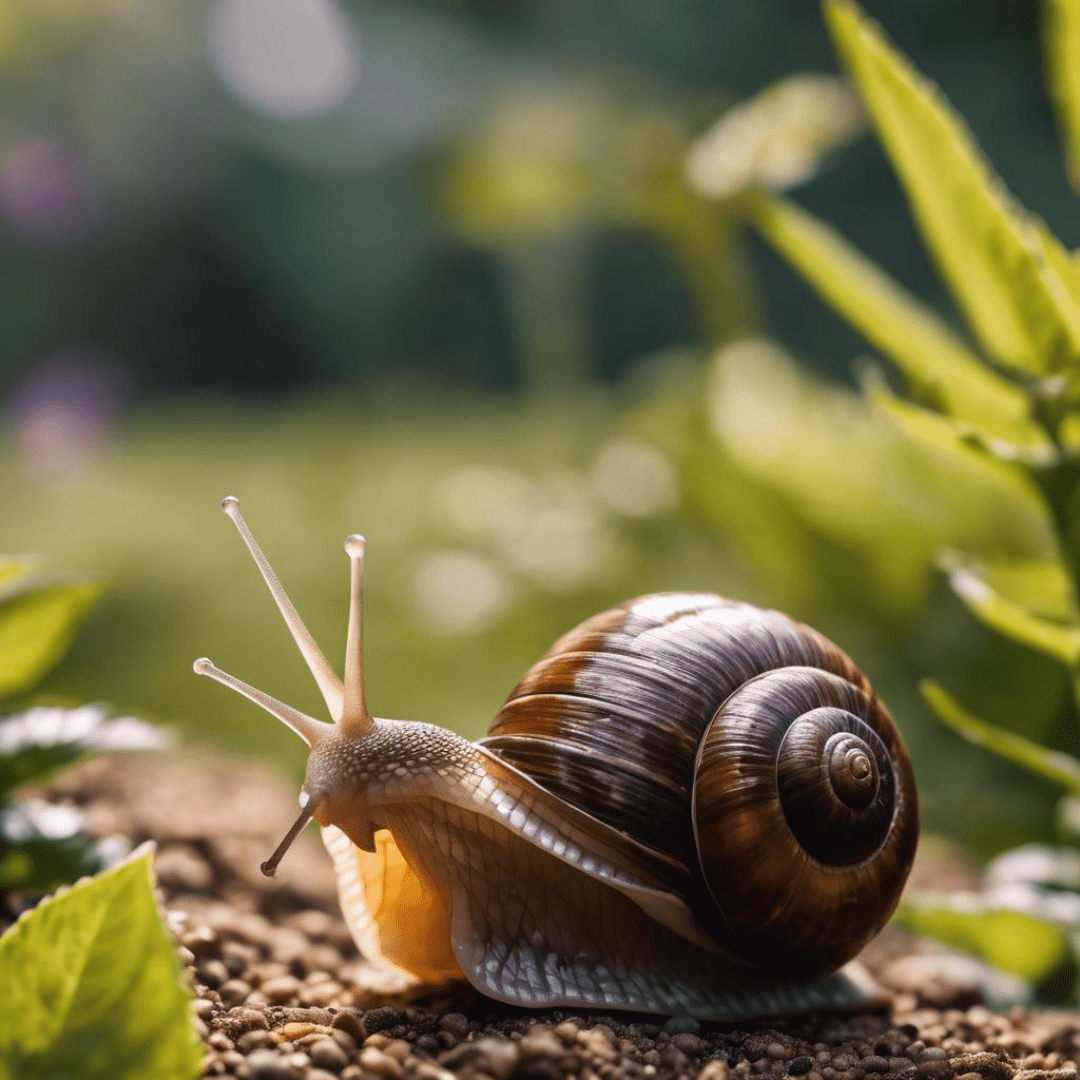Protect your garden from snails with my tried-and-true strategies for effective snail control. Learn natural and safe methods to keep your plants healthy while maintaining an eco-friendly garden.
I’ve spent years tending my garden, and one thing I’ve learned is that snails can be some of the sneakiest little pests out there. Left unchecked, they can wreak havoc on seedlings, leafy greens, and tender herbs. Over time, I’ve discovered several effective, safe, and natural strategies to keep snails under control without harming the environment. In this post, I’ll share the methods I rely on to protect my plants and maintain a healthy, thriving garden — all while staying true to eco-friendly practices.
This is a pinnable post. Tap or hover over any image in this post to pin to your Pinterest Boards.
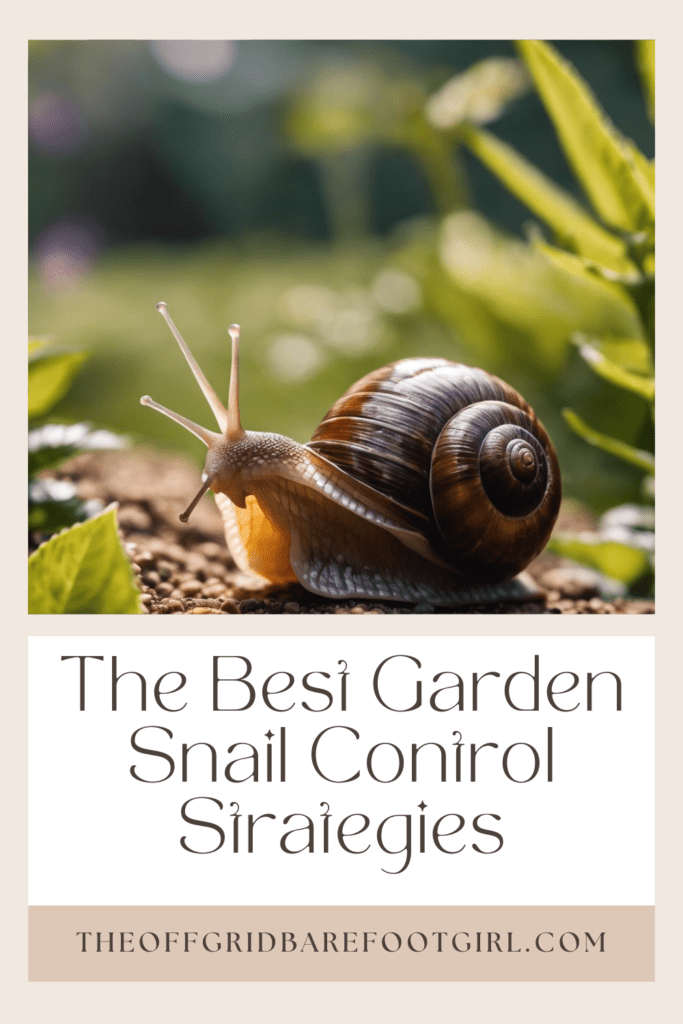
Introduction to Garden Snail Control
Understanding the Importance of Garden Snail Control
Garden snails may seem harmless, but they can wreak havoc on your plants and gardens if left unchecked. That’s why implementing effective snail control strategies is essential. By taking control of the snail population, you can protect your beloved plants and ensure a thriving garden.
The Impact of Garden Snails on Plants and Gardens
Garden snails can be voracious eaters, devouring your plants and leaving a trail of destruction in their wake. They have a particular affinity for tender leaves and stems, making your precious plants easy targets. Their feeding habits can lead to diminished crop yields, stunted growth, and even the death of your favorite flora. It’s time to fight back against these slimy invaders!
Understanding the Behavior and Biology of Garden Snails
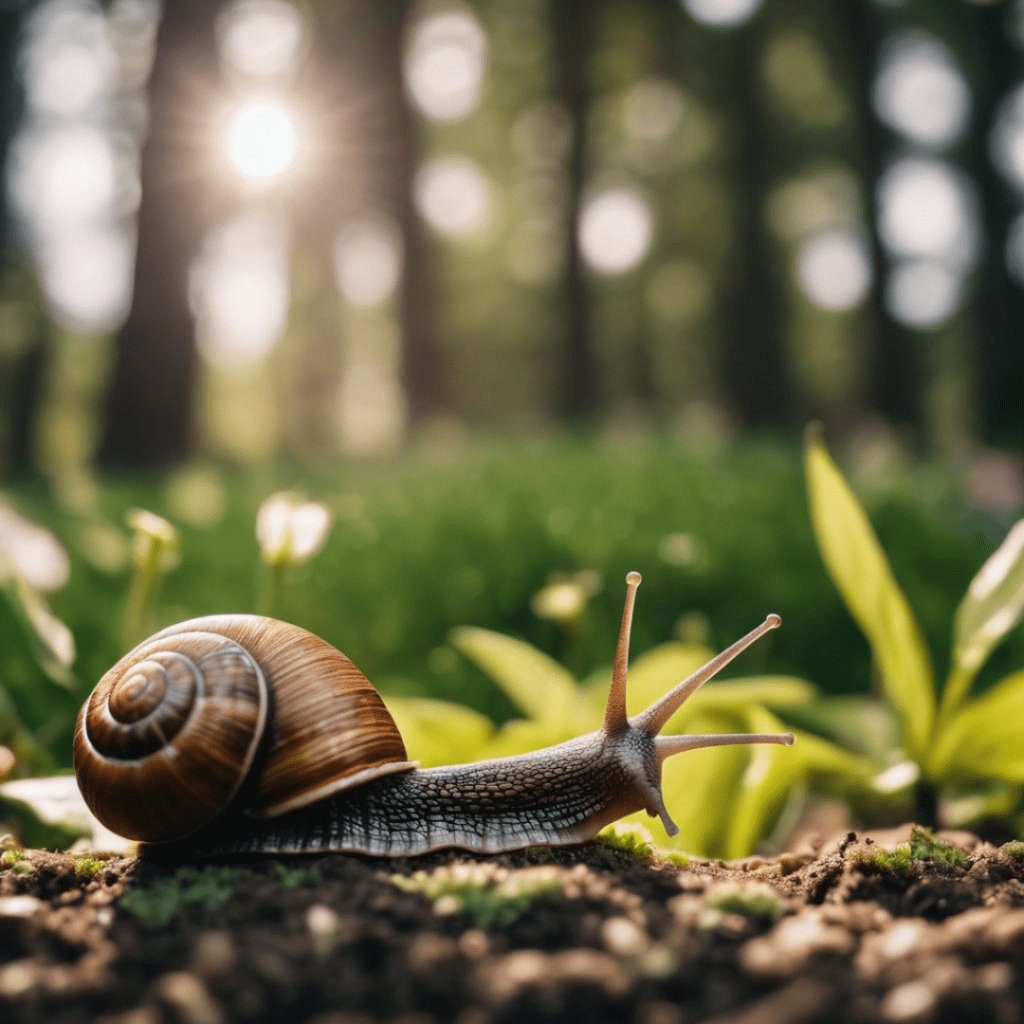
Life Cycle of Garden Snails
To effectively control garden snails, it’s important to understand their life cycle. Snails lay eggs in moist soil, and after a couple of weeks, small snails emerge. They grow rapidly, reaching maturity within a few months. This knowledge is crucial, as it helps you target snails at different stages of their life cycle for better control.
The life cycle of garden snails involves several stages. Here is a simplified list of the typical life cycle of garden snails:
- Egg Stage:
- Adult snails lay spherical, translucent eggs in clusters in moist soil. The number of eggs in a clutch can vary.
- Hatching:
- After a couple of weeks, the eggs hatch, and small snails emerge. The young snails already have a coiled shell.
- Juvenile Stage:
- The newly hatched snails go through a juvenile stage where they continue to grow and develop their shells. During this stage, they are more vulnerable to predators.
- Maturity:
- Snails reach maturity at around 6 to 12 months, depending on the species. Maturity is marked by the development of a fully formed and coiled shell.
- Reproduction:
- Adult snails are capable of reproducing. Most snails are nongender, meaning they have both male and female reproductive organs. They engage in mating, exchanging sperm with another snail.
- Egg-Laying:
- After mating, each snail can lay eggs, resulting in a new generation. The process repeats, contributing to the population growth of snails.
- Lifecycle Continuation:
- Snails can continue to lay eggs and reproduce throughout their lives. The life cycle is cyclical, with the population size influenced by factors like food availability, environmental conditions, and predation.
It’s important to note that the life cycle of garden snails can vary slightly between species, and environmental factors play a significant role in their development. Additionally, gardeners often view snails as pests due to their potential to damage plants and control measures may be implemented to manage their populations in cultivated areas.
Garden Snail Feeding Habits and Preferences
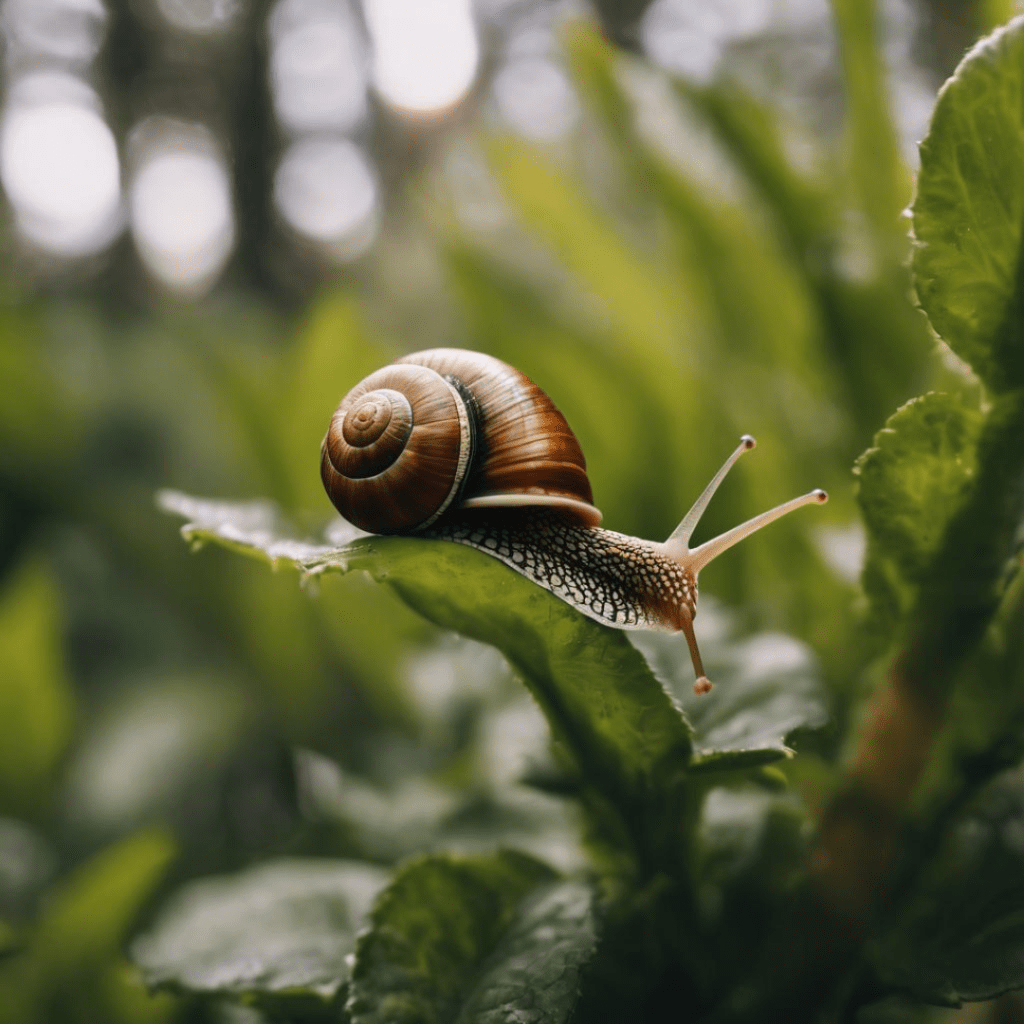
Garden snails have discerning tastes when it comes to their meals. They particularly enjoy feasting on young, succulent plants and vegetables. Leafy greens and delicate seedlings are like an all-you-can-eat buffet for these slimy creatures. By knowing their preferences, you can take measures specifically designed to protect the plants they find most irresistible.
Garden snails are known to feed on a variety of plants, and their preferences may vary depending on factors such as species, climate, and local vegetation. However, certain plants are commonly targeted by snails. Here’s a list of plants that garden snails are known to love:
- Lettuce (especially young leaves):
- Snails are particularly fond of the tender leaves of lettuce.
- Cabbage:
- Both cabbage leaves and seedlings can attract snails.
- Strawberries:
- Strawberries are often susceptible to snail damage, especially the ripening fruit.
- Hostas:
- Hosta plants are a favorite target for snails, and their leaves can show evidence of feeding damage.
- Seedlings:
- Snails may target young seedlings of various plants, especially when they are just starting to grow.
- Basil:
- Basil leaves are palatable to snails, and the herb is vulnerable to damage.
- Delicate Flowers:
- Flowers with soft, delicate petals, such as marigolds and pansies, may be eaten by snails.
- Lupines:
- Lupine plants can be attractive to snails, particularly when the foliage is young and tender.
- Petunias:
- Snails may feed on the soft, colorful petals of petunia flowers.
- Snapdragons:
- The tender blooms of snapdragons are susceptible to snail feeding.
- Dahlias:
- Dahlias, especially young shoots and tender foliage, can be a target for snails.
- Zinnias:
- Zinnia flowers, particularly the soft petals, may be eaten by snails.
It’s important to note that while snails may prefer these plants, they can also feed on a wide range of other vegetation. Implementing strategies to control snail populations, such as using barriers, natural predators, or organic snail repellents, can help protect vulnerable plants in your garden.
Environmental Factors that Attract Garden Snails
The environment plays a significant role in attracting garden snails. They thrive in damp and cool conditions, making your garden a prime location for their snail parties. Overwatering your plants or leaving standing water can create the perfect environment for snail infestations. By addressing these environmental factors, you can deter snails from making your garden their new favorite hangout spot. Here is a list of environmental factors that tend to attract garden snails:
- Moisture:
- Snails thrive in damp environments. Moist soil, especially after rainfall or watering, provides an ideal habitat for them.
- Mild Temperatures:
- Snails are more active during mild temperatures, typically between 50°F and 75°F (10°C to 24°C). Warmer conditions may increase their activity.
- Shelter and Hiding Places:
- Garden snails seek shelter during the day to avoid drying out and to protect themselves from predators. Dense vegetation, mulch, and other hiding spots attract snails.
- Organic Matter:
- Snails feed on decaying plant matter, and gardens with ample organic debris or mulch provide a food source for them.
- High Humidity:
- High humidity levels contribute to the moist conditions snails prefer. Gardens in regions with consistent humidity may have higher snail populations.
- Lush Vegetation:
- Gardens with a variety of lush plants, especially those with tender foliage, provide an abundant food source for snails.
- Irrigation Practices:
- Overwatering or poorly managed irrigation systems can contribute to consistently moist soil, creating an attractive environment for snails.
- Shady Areas:
- Snails are more active during the evening and night or on cloudy days. Shaded areas in the garden provide suitable conditions for their activity.
- Mulched Beds:
- Mulched garden beds not only retain moisture but also provide hiding places and a comfortable environment for snails.
- Lack of Natural Predators:
- Gardens with fewer natural predators of snails may experience higher snail populations. Birds, frogs, and predatory beetles are examples of snail predators.
- Ground Cover Plants:
- Low-growing ground cover plants can create a sheltered and humid environment that is attractive to snails.
- Compost Piles:
- Compost piles or heaps of organic matter may attract snails due to the abundance of decaying material.
Natural and Organic Methods for Controlling Garden Snails
Introduction to Natural Snail Control Techniques
If you prefer eco-friendly alternatives, natural snail control techniques are an excellent choice. These methods use non-toxic solutions, ensuring the well-being of both your plants and the environment. From homemade beer traps to copper barriers, there are plenty of creative and effective options that won’t harm your garden or your conscience.
Beer Traps and Their Effectiveness
Yes, you read that right – beer traps. Garden snails are attracted to the scent of yeast, making beer traps a popular and amusing method of control. Simply bury a shallow dish or container filled with beer in your garden, and the snails will be lured to their foamy demise.
Copper Barriers as a Natural Deterrent
Snails dislike crossing paths with copper. By creating a barrier using copper tape or sheeting, you can effectively prevent snails from reaching your plants. The copper delivers a mild electric shock to the snails, deterring them from venturing any further. It’s like installing a tiny electric fence for your garden – minus the hefty electricity bill.
Encouraging Natural Predators of Garden Snails
Sometimes, the best way to control a snail population is to let nature take its course. Encouraging natural predators like birds, frogs, and hedgehogs can help keep the snails in check. Consider creating a wildlife-friendly environment in your garden by providing shelter, food, and water sources for these helpful creatures.
More Effective Natural Garden Snail Control Methods
Controlling garden snails using natural methods is an environmentally friendly approach. Here’s a list of natural garden snail control methods:
- Handpicking:
- Regularly inspect your garden and manually remove snails. Wear gloves, especially during damp conditions when snails are more active.
- Eggshell Mulch:
- Crushed eggshells create a sharp barrier that snails are reluctant to crawl over. Spread crushed eggshells around susceptible plants.
- Coffee Grounds:
- Sprinkle used coffee grounds around plants. The abrasive texture can deter snails, and the acidity may be unfavorable for them.
- Diatomaceous Earth:
- Spread food-grade diatomaceous earth around plants. This powder is abrasive and dehydrates snails, causing them to die.
- Nematodes:
- Introduce beneficial nematodes to the soil. These microscopic organisms prey on snail eggs and larvae, helping to control the population.
- Natural Repellents:
- Sprinkle natural repellents like crushed garlic, citrus peels, or mint leaves around plants. These scents can deter snails.
- Companion Planting:
- Plant snail-resistant species or those that act as natural repellents near susceptible plants. For example, rosemary, sage, and fennel are known to repel snails.
- Cultural Practices:
- Keep the garden clean and free of debris, as this reduces hiding spots for snails. Water in the morning to allow the soil to dry out during the day, making it less favorable for snails.
- Salt Barriers:
- Create barriers using a ring of salt around plants. However, be cautious with this method, as salt can affect soil health and harm other plants.
Implementing a combination of these methods can be effective in managing garden snail populations without resorting to chemical pesticides. Adjust your approach based on the severity of the infestation and your specific garden conditions.
Chemical Options for Garden Snail Control
An Overview of Chemical Snail Control Methods
For those who prefer a more direct approach, chemical snail control methods can be effective. There are numerous snail baits and pesticides available in the market specifically designed to combat snail infestations. However, it’s essential to exercise caution and follow the instructions carefully to minimize any impact on beneficial insects or the environment.
Snail Baits and Their Proper Usage
Snail baits often contain substances that attract snails and are toxic to them. These baits can be applied strategically in your garden, focusing on areas where snails are most active. It’s important to follow the instructions for proper usage, applying the bait sparingly and away from desirable plants. This way, you can eliminate snails while minimizing any potential harm.
Considerations for Using Chemical Pesticides
Using chemical pesticides should be a last resort, but if all else fails, they can provide effective snail control. However, it’s crucial to consider their potential impact on the environment, including beneficial insects and other wildlife. Always choose pesticides that are specifically labeled for snail control and follow the instructions meticulously to ensure safe and responsible use.
Implementing Physical Barriers to Deter Garden Snails
Garden snails may be slow, but that doesn’t mean they can’t cause a lot of damage to your plants. One effective way to keep these slimy intruders out of your garden is by implementing physical barriers. There are a few types of barriers you can use, depending on your garden’s needs.
Types of Physical Barriers for Snail Control
One option is to create a barrier using materials such as copper tape or crushed eggshells. Snails are repelled by the electric charge produced by copper and dislike crawling over the sharp edges of eggshells. Simply apply the tape around the base of your plant or sprinkle crushed eggshells around the perimeter to create a snail-proof barrier.
Creating and Installing Snail-Repellent Fences
Another option is to build a snail-repellent fence. This can be done using materials like hardware cloth or plastic mesh. Make sure the fence is buried a few inches into the ground to prevent snails from crawling underneath. Remember, snails are clever critters, so make sure the fence is tall enough with copper mesh to discourage them from climbing over.
Using Cloches and Row Covers to Protect Plants
Cloches and row covers are great tools for protecting individual plants or entire rows from snail damage. These coverings create a physical barrier between the snails and your precious plants. Plus, they provide added protection against other pests as well as adverse weather conditions. Just be sure to regularly inspect the coverings for any snails sneaking in through small openings.
Gardening Practices to Prevent Snail Infestations
Prevention is always better than dealing with the aftermath of a snail invasion. By implementing a few smart gardening practices, you can greatly reduce the chances of snails taking over your garden.
Maintaining a Clean and Tidy Garden
Snails love to hide in cool, damp areas, so it’s important to keep your garden clean and tidy. Remove any debris, fallen leaves, or decaying vegetation where snails may seek shelter. Regularly mow the grass and trim overgrown plants to eliminate potential hiding spots.
Proper Watering Techniques to Reduce Snail Habitats
Snails thrive in moist environments, so adjusting your watering techniques can help deter them. Instead of overhead watering, which keeps the top layer of soil constantly damp, consider using a drip or soaker hose to deliver water directly to the plant roots. This method will keep the soil moist for your plants without creating a snail-friendly habitat.
Removing Potential Hiding Places for Garden Snails
Snails are notorious for hiding in nooks and crannies, so it’s important to remove any potential hiding places. Check your garden for objects such as pots, boards, or stones that provide dark, moist environments perfect for snails. By eliminating these hiding spots, you’ll make your garden a less attractive destination for these slimy pests.
Integrated Pest Management Techniques for Long-Term Snail Control
To tackle snail infestations in the long run, it’s best to adopt an integrated pest management approach. This means combining multiple snail control methods to achieve the best results.
Understanding the Concept of Integrated Pest Management
Integrated pest management involves using a combination of cultural, physical, biological, and chemical controls to manage pests effectively. By utilizing different approaches, you can target pests at various stages of their life cycle and reduce the need for excessive pesticide use.
Combining Different Snail Control Methods for Better Results
Incorporate a variety of strategies from physical barriers and traps to natural predators and organic repellents. By diversifying your snail control methods, you’ll create a more hostile environment for snails and increase your chances of success.
Monitoring and Regular Inspection for Early Detection
Regular monitoring and inspection of your garden are crucial for identifying snail infestations early on. Take the time to check under leaves, in crevices, and along the base of plants. By catching snails in the early stages, you can prevent them from multiplying and causing significant damage.
Recommendations for Effective Garden Snail Control
Garden snails may be slow, but with the right strategies, you can stay one step ahead of them. Here’s a summary of the most effective garden snail control strategies:
Summary of Effective Garden Snail Control Strategies
- Implement physical barriers using materials like copper tape or crushed eggshells.
- Build snail-repellent fences using hardware cloth or copper mesh.
- Use cloches and row covers to protect plants from snail damage.
- Maintain a clean and tidy garden by removing debris and trimming vegetation.
- Adjust watering techniques to reduce snail habitats.
- Eliminate potential hiding places for snails by removing objects like pots and stones.
- Adopt an integrated pest management approach by combining various control methods.
- Regularly monitor and inspect your garden for early detection of snail infestations.
Choosing the Most Suitable Methods for Your Specific Garden
Remember, every garden and every gardener is unique. Experiment with different strategies to find the ones that work best for you. Don’t be discouraged if one method doesn’t yield immediate results – snails are persistent creatures, but so are you! With a bit of determination and the right snail control strategies, your garden will be snail-free and flourishing in no time.
Conclusion
In conclusion, managing garden snails requires a combination of proactive measures and strategic approaches. By understanding the behavior and biology of these pests, we can implement natural and organic methods like beer traps, copper barriers, and encouraging natural predators. Additionally, chemical options and physical barriers can provide effective control. Incorporating good gardening practices and adopting integrated pest management techniques will contribute to long-term snail control. By implementing these strategies, you can protect your garden from snail infestations and enjoy a thriving and healthy oasis of plants and flowers. With a little effort and the right techniques, you can successfully keep garden snails at bay and create a beautiful and flourishing garden.
Remember, it’s your garden, and you have the power to protect it from these slimy intruders. So, gear up and show those snails who’s boss!
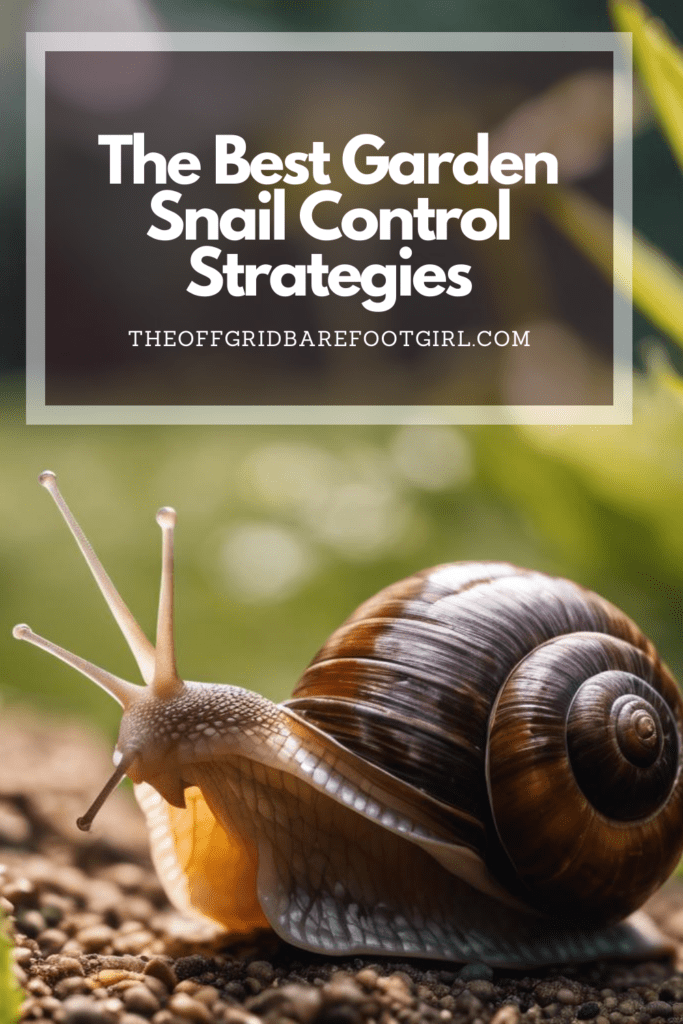
Frequently Asked Questions
1. Are natural and organic methods for snail control effective?
Yes, natural and organic methods can be effective in controlling garden snails. Techniques such as beer traps, copper barriers, and encouraging natural predators can help reduce snail populations. However, it’s important to note that these methods may require consistent application and monitoring to achieve desired results.
2. Are chemical options safe for my garden and the environment?
When using chemical options for snail control, it is crucial to follow the instructions provided by the manufacturer. Some chemical pesticides specifically formulated for snails can be effective, but they should be used with caution. Always consider potential risks to the environment, beneficial insects, and other wildlife when using chemical options. If possible, explore natural and organic alternatives before resorting to chemical options.
3. How do I choose the most appropriate snail control method for my garden?
The most appropriate snail control method for your garden depends on various factors, including the severity of the snail infestation, the size of your garden, and your personal preferences. It is recommended to start with natural and organic methods and evaluate their effectiveness. If the problem persists, you can consider implementing physical barriers or, as a last resort, chemical options. Integrated pest management techniques, which combine multiple strategies, can also be effective for long-term control.
4. How can I prevent snail infestations in the first place?
To prevent snail infestations, maintaining a clean and tidy garden is essential. Remove debris, fallen leaves, and other potential hiding places for snails. Avoid overwatering, as moist environments are attractive to snails. Regularly inspect your plants for early signs of snail damage and take prompt action if you spot any. Implementing good gardening practices, such as proper spacing between plants and avoiding excessive use of nitrogen-rich fertilizers, can also make your garden less favorable to snails.
Summary
I hope I have inspired you to plant your garden with these tips and products.
If you were encouraged by this post, I invite you to check out my FREE Printables Page for fun free printables, planners, and charts.
ENTER MY FREE Printables Page HERE
Here are some more of my gardening inspiration posts to check out!
How to Grow Your Own Food Without a Backyard!
My Best Spring Garden Posts in One Spot!
Spring Garden Soil Prep: How to Improve Your Soil
Seed Starting Mix 101: Everything You Need to Know!
How to Plan a 200 Sq. Ft. Vegetable Garden Layout
How I Easily Start My Seeds Without Expensive Grow Lights!
How to Create a Smart Garden: Tech Meets Nature!
The Best Cheap Raised Vegetable Garden Beds
How to Grow Artichokes: Plant Once and Harvest for 5 Years!
The Best 8 Fast-Growing Vegetables In Just 45 Days!
From Snow to Sow: Plan Your Spring Garden Now!
11 Fun Ways to Brighten Your Spring Garden with Personality
Top 10 Spring Garden Crops to Harvest in 30 Days and Eat Now!
The Best Survival Crops for Caloric Survival
My Victory Garden: What I Learned from 5+ Years
Why Every Family Should Have a Victory Garden in Their Backyard Now!
The Best Perennials for a Long-Term Survival Garden
The Best Essential Oils for Plants That Repel Garden Bugs
More Gardening Projects!
How to Grow Green Garden Peas: Perfect Plump Peas!
Hugelkultur: Does This Epic Pioneering Method Actually Work?
9 Ways to Celebrate Earthing Day in Your Garden!
Gardening Indoors: Secrets of Growing Your Food Inside!
How to DIY a Milk Jug Drip Irrigation System!
Why Cedar Mulch Is The Perfect Natural Weed Barrier
Gardening Projects
Onions: How to Grow Onions for Storage
Peas: How to Grow Garden Peas for a Bumper Crop
Carrots: How to Grow Carrots for a Bountiful Harvest
Prep Your Garden for Spring Planting with These Expert Tips!
How to Grow a Prepper Garden to Survive and Thrive
The Best Garden Tools You Need for a Productive Season
Fastest Growing Vegetables for Your Survival Garden
How to Grow Marigolds As Pest Control In Your Vegetable Garden
Must-Have Tools for a Successful Balcony Vegetable Garden
How to Effectively Combat Powdery Mildew in Your Garden
The Best Tips for Organic Gardening
How to Release Ladybugs In Your Garden for Organic Pest Control
The Best Garden Snail Control Strategies
The Best Spring Vegetables to Grow in Your Garden
Seed Starter Mix: How To Make Your Organic Seed Starter Mix At Home
How to Grow a Productive Canning Garden
How to Plant and Grow a Salsa Garden
Easiest Heirloom Vegetable Seeds to Grow Now
How to Use the Hand Twist Claw Tiller: Tackling Tough Soil
More Fun Gardening Posts to Check Out!
Planning Your Garden: How to Plan a Vegetable Garden: Expert Green Thumb Tips!
Winterizing the Garden: How to Winterize Your Vegetable Garden: Step-by-Step Checklist
Mulching the Garden: How to Make Leaf Litter Mulch
Grow a Pumpkin Patch: How to Grow a Pumpkin Patch in Your Backyard
How to Grow a Fall Garden: 9 Best Fall Crops
Clever Ways to Incorporate Indoor Composting into Your Home
How to Start Composting for the Garden: A Step-by-Step Guide
The Ultimate Guide to Composting in Your Suburban Backyard
Why I Built A Survival Garden in My Backyard
16 Best Medicinal Herbs to Grow in Your Garden Now
Blessings,
The Off Grid Barefoot Girl

